
The Most Noble Order of the Garter is an order of chivalry founded by Edward III of England in 1348. The most senior order of knighthood in the British honours system, it is decoration outranked in precedence only by the Victoria Cross and the George Cross. The Order of the Garter is dedicated to the image and arms of Saint George, England's patron saint.

The College of Arms, or Heralds' College, is a royal corporation consisting of professional officers of arms, with jurisdiction over England, Wales, Northern Ireland and some Commonwealth realms. The heralds are appointed by the British Sovereign and are delegated authority to act on behalf of the Crown in all matters of heraldry, the granting of new coats of arms, genealogical research and the recording of pedigrees. The College is also the official body responsible for matters relating to the flying of flags on land, and it maintains the official registers of flags and other national symbols. Though a part of the Royal Household of the United Kingdom, the College is self-financed, unsupported by any public funds.

New Zealand Herald of Arms Extraordinary is the officer of arms responsible for the regulation of heraldry in New Zealand. Although affiliated with the College of Arms in London, the New Zealand Herald lives and works in New Zealand, and is not a member of the College Chapter. The current New Zealand Herald of Arms Extraordinary is Phillip Patrick O'Shea.

Norroy and Ulster King of Arms is the provincial King of Arms at the College of Arms with jurisdiction over England north of the Trent and Northern Ireland. The two offices of Norroy and Ulster were formerly separate. Norroy King of Arms is the older office, there being a reference as early as 1276 to a "King of Heralds beyond the Trent in the North". The name Norroy is derived from the Old French nort roy meaning 'north king'. The office of Ulster Principal King of Arms for All-Ireland was established in 1552 by King Edward VI to replace the older post of Ireland King of Arms, which had lapsed in 1487.

Richmond Herald of Arms in Ordinary is an officer of arms of the College of Arms in England. From 1421 to 1485, Richmond was a herald to John, Duke of Bedford, George, Duke of Clarence, and Henry, Earl of Richmond, all of whom held the Honour (estate) of Richmond. However, on the accession of Henry as Henry VII of England in 1485, Richmond became a king of arms and remained so until 1510, when the office became that of a herald in ordinary of the Crown. The badge of office is a red rose of Lancaster dimidiating the white rose en soleil of York, ensigned by the royal crown. Although this device has all the characteristics of a Tudor invention, it is likely to be of fairly recent derivation.
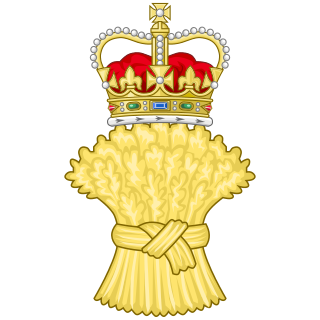
Chester Herald of Arms in Ordinary is an officer of arms at the College of Arms in London. The office of Chester Herald dates from the 14th century, and it is reputed that the holder was herald to Edward, Prince of Wales, also known as the Black Prince. In the reign of King Richard II the officer was attached to the Principality of Chester, which was a perquisite of the then Prince of Wales. In the reign of King Henry VIII the title lapsed for a time but, since 1525, the office of Chester has been one of unbroken succession, as a herald in ordinary. The badge of office is taken from the arms of the Earl of Chester and in blazoned as A Garb ensigned of the Royal Crown Or.
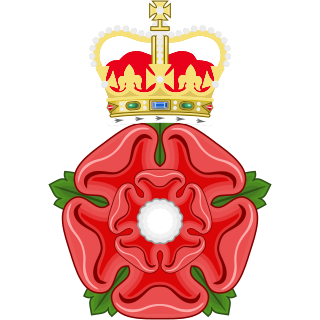
Lancaster Herald of Arms in Ordinary is an English officer of arms at the College of Arms in London. The title of Lancaster Herald first occurs in 1347 at Calais, and to begin with this officer was a servant to the noble house of Lancaster. As a retainer of John of Gaunt (1377–1399) Lancaster was advanced to the rank of King of Arms, and was later promoted to the royal household of Henry IV, and made king of the northern province. This arrangement continued until 1464, when Lancaster reverted to the rank of herald. Since the reign of King Henry VII (1485–1509) Lancaster has been a herald in ordinary. The badge of office is a red rose of Lancaster, royally crowned.

York Herald of Arms in Ordinary is an officer of arms at the College of Arms. The first York Herald is believed to have been an officer to Edmund of Langley, Duke of York around the year 1385, but the first completely reliable reference to such a herald is in February 1484, when John Water alias Yorke, herald was granted certain fees by Richard III. These fees included the Manor of Bayhall in Pembury, Kent, and 8 pounds, 6 shillings, and 8 pence a year from the Lordship of Huntingfield in Kent. The badge of office is the White Rose of York en soleil ensigned by the Royal Crown.

Somerset Herald of Arms in Ordinary is an officer of arms at the College of Arms in London. In the year 1448 Somerset Herald is known to have served the Duke of Somerset, but by the time of the coronation of King Henry VII in 1485 his successor appears to have been raised to the rank of a royal officer, when he was the only herald to receive coronation liveries.
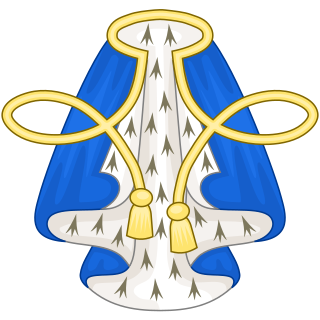
Bluemantle Pursuivant of Arms in Ordinary is a junior officer of arms of the College of Arms in London. The office is reputed to have been created by King Henry V to serve the Order of the Garter, but there is no documentary evidence of this. There is, however, mention of an officer styled Blewmantle going to France in 1448. The first Bluemantle to be mentioned by name is found in a record from around 1484. The badge of office, probably derived from the original blue material of the Order of the Garter, is blazoned as A Blue Mantle lined Ermine cords and tassels Or.

Portcullis Pursuivant of Arms in Ordinary is a junior officer of arms at the College of Arms in London. The office is named after the Portcullis chained Or badge of the Beauforts, which was a favourite device of King Henry VII. King Henry's mother was Lady Margaret Beaufort. The office was instituted around 1485, probably at the time of Henry's coronation. The badge of office is very similar to that of Somerset Herald of Arms in Ordinary, the latter being ensigned with the Royal Crown. The earliest recorded Portcullis Pursuivant was James or Jacques Videt, who was the plaintiff in a Common Pleas case in 1498 and again in 1500.

David Hubert Boothby Chesshyre was a British officer of arms.
Sir Henry Farnham Burke, (1859–1930) was a long-serving Anglo-Irish officer of arms at the College of Arms in London.
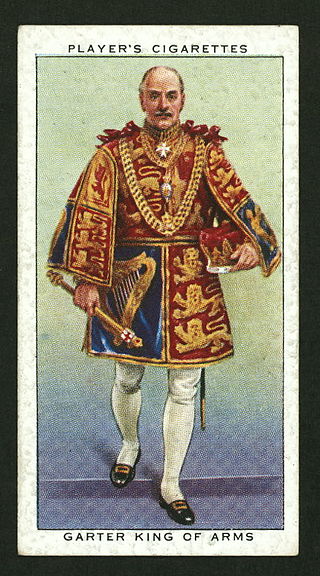
Sir Gerald Woods Wollaston was a long-serving officer of arms at the College of Arms in London. Wollaston's family had a firm tradition at the College of Arms. Wollaston's great-grandfather was Sir William Woods, Garter Principal King of Arms from 1838 until his death in 1842. His grandfather was Sir Albert William Woods who held the same post from 1869 to 1904.
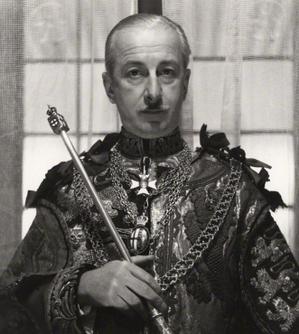
Sir George Rothe Bellew,, styled The Honourable after 1935, was a long-serving herald at the College of Arms in London. Educated at the University of Oxford, he was appointed Portcullis Pursuivant in 1922. Having been Somerset Herald for 24 years, he was promoted to the office of Garter Principal King of Arms in 1950, the highest heraldic office in England and Wales. He served in that capacity until his resignation in 1961. As Garter, Bellew oversaw the funeral of George VI, proclaimed the late King's daughter, Elizabeth II, as Queen and took a leading role in the organisation of her Coronation in 1953. After his retirement, Bellew was Secretary of the Order of the Garter and Knight Principal of the Imperial Society of Knights Bachelor. He lived for many years at Dower House in Old Windsor, Berkshire, but later moved to Farnham and died in 1993, aged 93.

Richard Preston Graham-Vivian was a long-serving English officer of arms at the College of Arms in London. He was the younger son of Sir Richard James Graham, 4th Baronet, and Lady Mabel Cynthia Duncombe.

Timothy Hugh Stewart Duke, FSA is an officer of arms at the College of Arms in London.
Alfred Trego Butler MVO, MC, FSA, FASG was a genealogist and officer of arms at the College of Arms in London.
Blanche Lyon Pursuivant of Arms in Ordinary was an English office of arms created during the reign of King Edward IV.
The Gentleman Usher of the Scarlet Rod is the Gentleman Usher to the Most Honourable Order of the Bath, established 14 January 1726.
























































